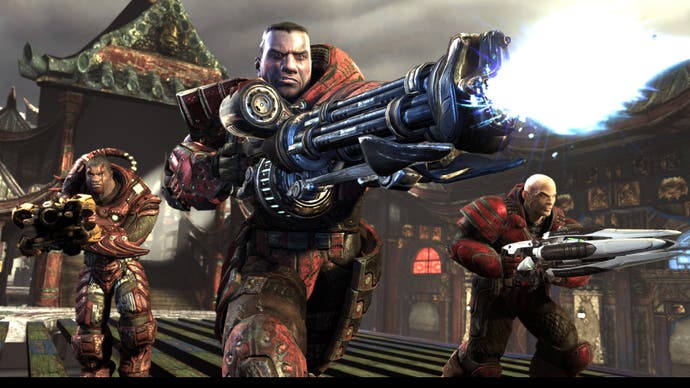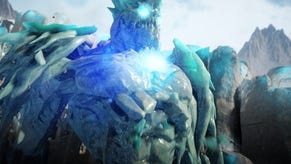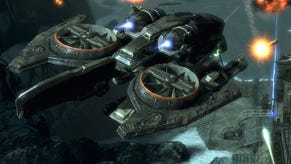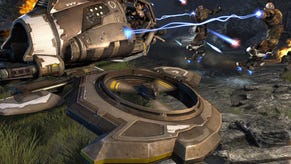Unreal Tournament 3
Killing spree!
Unreal Tournament 3's most eye-catching new feature is a two-metre-square block of pink gelatinous wibble that Epic is currently calling the "slow bubble". Once deployed, it slows the pace of anything that passes through it to a crawl. You can fire a rocket into one end and then run round the side and watch it slowly carve through the centre, before resuming its breakneck pace as it exits. More usefully, you can also dump it in a corridor that chokes your enemy's progress and use it like a flytrap, snaring the opposition and then blasting them at will. And, brilliantly, anybody stuck inside also gets to watch your bullets seep towards them at the same gradual pace that prevents them getting out of the way. Surely this is the best deployable since Armed & Dangerous' rarely mentioned shark that leaps out of the ground and eats you when you walk over it, if not the can of Red Bull I just found in my desk drawer.
Not that the blobosquirm is the focus of Epic's presentation at E3, of course. That would be silly. But, having been up for 48 hours at the point it creeps across producer Jeff Morris's screen, it was the thing that jolted me back to life, and thus deserves celebration.
Unreal Tournament 3 (it's "3" rather than "4" because Epic considers UT 2003 and 2004 to be part of the same "series") is the latest instalment in the arena-based multiplayer shooter series that gave us the asymmetric "Assault" team-play principle, the pilotable Redeemer mega-weapon, the concept of "mutators" and a viable alternative to id Software's 1990s FPS monopoly. "We're keeping this one to a set number of game modes, and making sure we pack as much into them as possible," says Morris, introducing the game in a crowded corner of Midway's suite at the Loews Hotel in Santa Monica, when asked to explain the thinking. To that end we've got Deathmatch, Team Deathmatch, Capture the Flag and Warfare. Gone (to some extent) are Assault, Double Domination, Invasion, Bombing Run and Mutant, although vehicle-CTF is reportedly still in there. "Streamlined" is the word.

"With Warfare, we're combining the best parts of Onslaught and Assault, and including a bunch of cool things we haven't seen before," says Morris. Warfare is a team-based mode that sees bands of players working together to capture nodes on the way to the enemy's power-core. Each Warfare map has a number of nodes, and taking each over can represent the same kind of asymmetric struggle as Assault, while preserving the vehicle-based combat and equipment elements of Onslaught. One of the benefits of this node-based concept is that a large map doesn't become stretched, as individual nodes become points of focus; a sort of "moving battlefront" as Morris puts it. That comment, and the way he talks about concentrating gameplay in Warfare, echoes a lot of the sense that Valve makes when it talks about Team Fortress 2's 'Hydro' map, for those familiar with that.
Individual nodes offer other benefits too. Some are paired with turret-guns, and those suddenly rolling their eyes would do well to centre the view again, because these - if you'll forgive the phrase - are no ordinary turrets. Well, they are, but they're attached to rails. In the example we're shown, a turret can be manoeuvred the whole way around a circular fountain in a town square, giving the defending team a greater range of strategic options. You'll also be able to go after nodes slightly off the beaten track - they won't necessarily be on the path to the opposing power-core, but they will give you other benefits, like access to some of UT's meatier vehicles. You know, the Leviathan.

Most of UT 2004's vehicles return, but with the addition of alien species the Necris you also gain access to more unusual options. Morris brings up the word "asymmetric" again. "Axon [the goodies] vehicles may not have an exact counterpart, but they're balanced against them," he explains. We're first shown the Dark Walker, which is an insectoid crawler with three spindly tentacle legs that creeps around in a bubble of energy, able to jump to scale the crumbling environments and tuck in its tentacles to roll around fearsomely, also firing twin laser-beams and screaming to knock enemies off their feet as a secondary attack. "That's horrible," one of our fellow watchers exclaims as it sashays gruesomely over a hill. The Necris also have more manoeuvrable alternatives as well as a stealth option (although we don't see it - ho ho) and both sides have aerial options, including the Axons' Cicada gunship. "Cicada" being one of my favourite words ever.
Vehicles give a team greater strength, but individuals can call upon a typically vast and diverse range of weapons too. UT favourites the Impact Hammer, Shock Rifle, Bio Rifle, Flak Cannon, Rocket Launcher, Sniper Rifle and Translocator are in, along with the Redeemer. The AVRiL rocket launcher is also back for smashing up vehicles, as is the Link Gun, which can be used to help speed up the takeover of nodes in Warfare at the obvious expense of peripheral vision and, you know, any form of personal defence. Then there are the power-ups and equipment like the slow bubble, or the "berserk" tool, which increases your rate of fire dramatically for a short period. id should sue. Although if they could hang on until UT3's out that'd be preferable - don't want them jeopardising our fun, innit.









